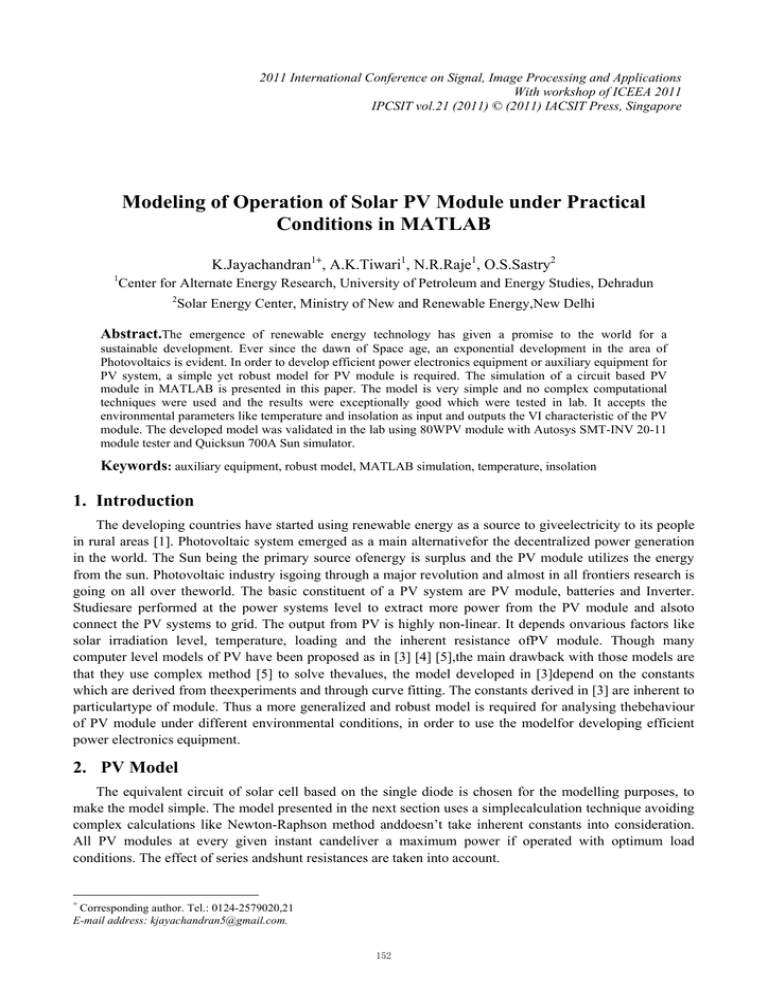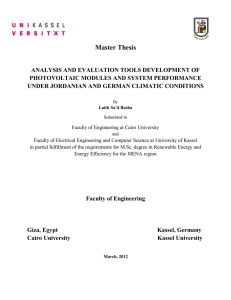Document 13134648
advertisement

2011 International Conference on Signal, Image Processing and Applications With workshop of ICEEA 2011 IPCSIT vol.21 (2011) © (2011) IACSIT Press, Singapore Modeling of Operation of Solar PV Module under Practical Conditions in MATLAB K.Jayachandran1+, A.K.Tiwari1, N.R.Raje1, O.S.Sastry2 1 Center for Alternate Energy Research, University of Petroleum and Energy Studies, Dehradun 2 Solar Energy Center, Ministry of New and Renewable Energy,New Delhi Abstract.The emergence of renewable energy technology has given a promise to the world for a sustainable development. Ever since the dawn of Space age, an exponential development in the area of Photovoltaics is evident. In order to develop efficient power electronics equipment or auxiliary equipment for PV system, a simple yet robust model for PV module is required. The simulation of a circuit based PV module in MATLAB is presented in this paper. The model is very simple and no complex computational techniques were used and the results were exceptionally good which were tested in lab. It accepts the environmental parameters like temperature and insolation as input and outputs the VI characteristic of the PV module. The developed model was validated in the lab using 80WPV module with Autosys SMT-INV 20-11 module tester and Quicksun 700A Sun simulator. Keywords: auxiliary equipment, robust model, MATLAB simulation, temperature, insolation 1. Introduction The developing countries have started using renewable energy as a source to giveelectricity to its people in rural areas [1]. Photovoltaic system emerged as a main alternativefor the decentralized power generation in the world. The Sun being the primary source ofenergy is surplus and the PV module utilizes the energy from the sun. Photovoltaic industry isgoing through a major revolution and almost in all frontiers research is going on all over theworld. The basic constituent of a PV system are PV module, batteries and Inverter. Studiesare performed at the power systems level to extract more power from the PV module and alsoto connect the PV systems to grid. The output from PV is highly non-linear. It depends onvarious factors like solar irradiation level, temperature, loading and the inherent resistance ofPV module. Though many computer level models of PV have been proposed as in [3] [4] [5],the main drawback with those models are that they use complex method [5] to solve thevalues, the model developed in [3]depend on the constants which are derived from theexperiments and through curve fitting. The constants derived in [3] are inherent to particulartype of module. Thus a more generalized and robust model is required for analysing thebehaviour of PV module under different environmental conditions, in order to use the modelfor developing efficient power electronics equipment. 2. PV Model The equivalent circuit of solar cell based on the single diode is chosen for the modelling purposes, to make the model simple. The model presented in the next section uses a simplecalculation technique avoiding complex calculations like Newton-Raphson method anddoesn’t take inherent constants into consideration. All PV modules at every given instant candeliver a maximum power if operated with optimum load conditions. The effect of series andshunt resistances are taken into account. + Corresponding author. Tel.: 0124-2579020,21 E-mail address: kjayachandran5@gmail.com. 152 The developed model was validated in the lab for different conditions like variousirradiation levels and constant temperature, varying temperature and constant irradiation level,varying temperature and varying irradiation. The results were presented in section 3. Fig 1: Equivalent circuit of PV cell The following are the equations which govern the generation of current and voltage. I=IL-I0 IL= 1 - (1) (2) [Isc +ki(Tc-TR)] I0 (T1) = (3) I 0= (4) Voc= ln (5) Conversely Rs can be calculated from the model by using the method developed in [6] [7] the Rs can be calculated from single insolation level. Rs= - ln (6) Rsh= (7) It can observed from the above relations that IL Irradiation Voc ambient Temperature The temperature does have an effect on the value of ‘Isc’. The temperature coefficient forcurrent and voltage can be got from the manufacturer or can be calculated from the lab.Typical VI curve for a PV module will look like as in fig 2. From the curve we can observethat at the knee of the curve the maximum power is delivered. This condition occurs at optimum load conditions or when the equivalent resistance as seen from the photovoltaicmodule is equal with the load. 2.1. MATLAB modelling of the PV module The equations (1)-(7) are computed in MATLAB. The considerations in the model are 1. 2. 3. 4. 5. Series resistance (Rs)can be either given as an input parameter or it can also be calculated using a single curve method[6] Rsh to account for the leakage current Temperature dependence of photo generated current (IL) and reverse saturation current (Io) Temperature dependence of Voc Consideration of the effect of ‘n’ or ideality factor The model accepts temperature, irradiance, series and shunt resistance as input and givesVI curve as output. Also various parameters like Io, Rs, Rsh, ILare also calculated. It should benoted that the power 153 delivered by a PV module will depend on the load conditions and only at optimum load maximum power transfer will occur and thispoint is Maximum power point (Pmax) and the corresponding voltage and current are calledVmax, Imax respectively. Another important factor to be taken into account is ‘n’ whichtakes a value in between 1-2. An estimate should be made for n. It has been suggested innominal operation the value will be around 1.6[2]. Fig 2: V-I curve of the module for different irradiation levels (0-80 mW/m2) 3. Validation of the Model Module used was Reliance 80W multicrystalline. The module was tested in both Quick sun 700A sunsimulator and Autosys SMT-INV 20-11 and the results showed excellent correlation. Thefollowing table gives us the temperature and irradiation variation input also themanufacturer’s data for PV module are given below. Fig 3: Test module 154 Table 2: Autosys SMT-INV 20-11 test simulator Table 1 Specifications of the test module Model no Type Voc Isc Pmax Vmax Imax Rseries Rshunt FF Efficiency MM09135169-Reliance Multi 21.7 5.2 80 W 17.2 V 4.7 A 0.771 55.46 66.05% 12.3% Irradiation Temperature Test results Model result 700 25 57.92 57.65 800 25 66.02 65.12 900 25 74.19 73.29 1000 25 82.08 80.86 1100 25 90.39 89.12 Table 3: Quick sun 700A sun simulator results Test Model Irradiation Temperature results result °c W/m2 Pmax Pmax (W) (W) 1000 65 76.9 75.8 200 60 15.3 16 300 55.5 24.1 25.8 400 52.3 33.2 33.1 500 50 42.3 42.4 600 47.5 51.5 50.4 700 43 61.4 62.3 800 41.6 70.6 70.1 900 37 80.5 79 400 35 35.4 32.6 200 32 17.2 18.4 The important observation which has come as the outcome of the project is 1. Increase in the resistance or variation in the resistance of the PV module is mainlydue to the change in irradiance and the effect of temperature is very less on thevariation of series resistance. This can be noted in the following table obtained inmodelling and verified in lab. Irradiation (W/m2) Temperature (°c) Series resistance 200 200 400 400 1.5 1.390 0.854 0.809 65 32 52.3 35 155 Table 4 Variation of resistance 2. Value of ‘n’ plays a major role. As fixing its value in-between 1 to 2 decides the better operation of developed model. This can be done on the basis of trial and error method. Keeping the value near 1 indicates ideal operation and value near to 2 makesit unattainable condition. 4. Results and Conclusion The value obtained from the simulation and the lab values are almost the same. Thus asimple model to study the PV module was developed without any complexity by taking allthe factors in to account. The above model can be used to develop power electronics basedconverters. Also this model can be further developed to study the effect of degradation in modules 5. Acknowledgement The authors would like to acknowledge the Ministry of New and Renewable Energy, Government of India and University of Petroleum and Energy Studies for extending their support in this project. 6. References [1] Luque, and S. Hegedus (Eds.), Handbook of Photovoltaic Science andEngineering, John Wiley & Sons Ltd., 2003. [2] T. Markvart, and L. Castaner (Eds.), Practical Handbook of Photovoltaics:Fundamentals and Applications, Elsevier Ltd., 2003. [3] J. A. Gow, C. D. Manning “Development of a photovoltaic array model for use inpower electronics simulation studie,” IEE Proceedings on Electric PowerApplications, vol. 146, no. 2, pp. 193- 200, March 1999. [4] Francisco M. González,Longatt, “Model of Photovoltaic Module in Matlab”,2DO Congreso Iberoamericano de estudintes de ingenieria electrica, electronica ycomputacion(II ibelec 2005). [5] Hansen, P. Lars, H. Hansen and H. Bindner. “Models for Standalone PV System”Risø National Laboratory, Roskilde, December 2000, ISBN 87-550-2776-8.[Online]. Available: http://www.risoe.dk/rispubl/VEA/ris-r1219.htm [6] Gerald Kunz, Andres Wagner “Internal series resistance determinate of only oneIV curve under illumination” 19th European Photovoltaic Solar energyconference ,Paris, France. [7] Andreas wagner “Peak-power and internal series resistance measurement undernatural ambient conditions” Eurosun 2000 Copenhagen. 156






